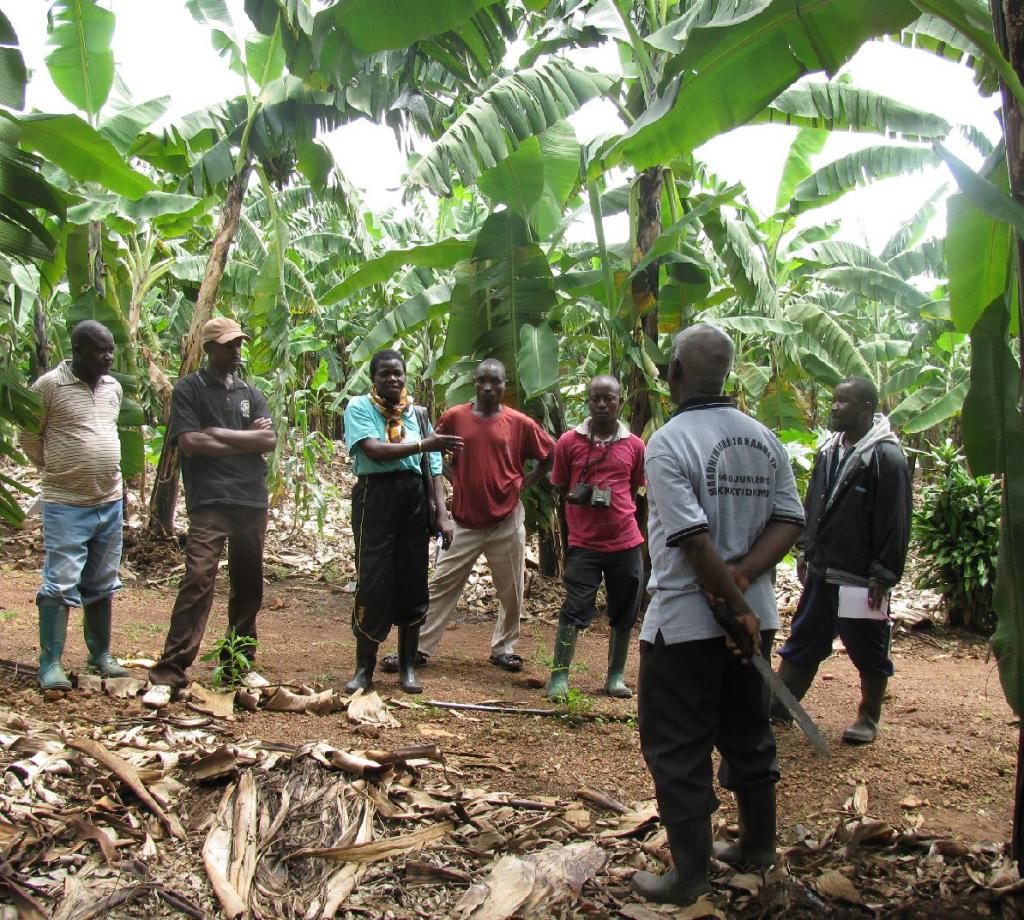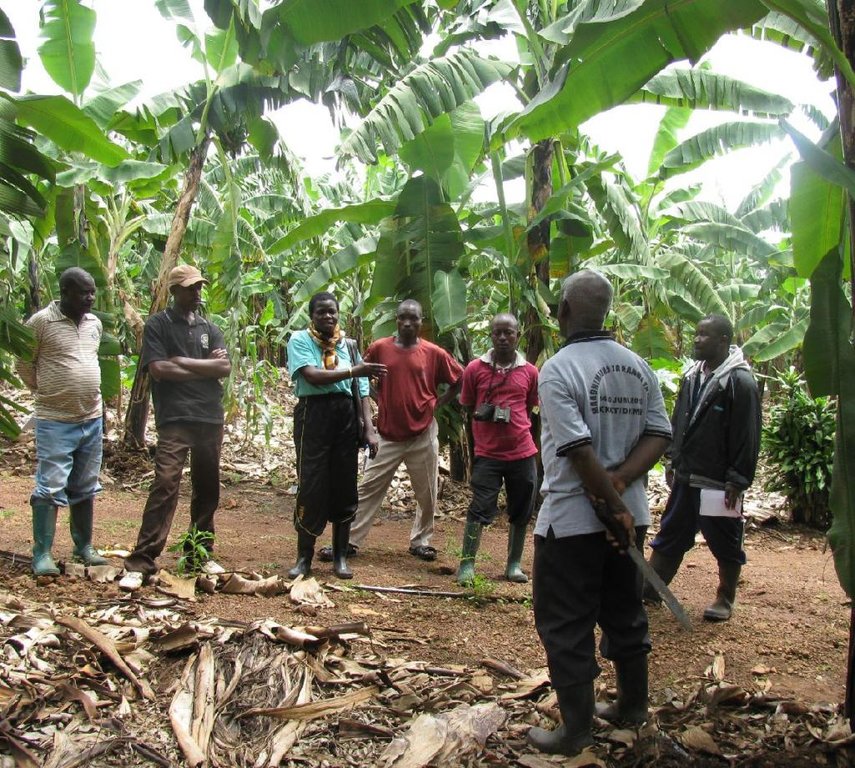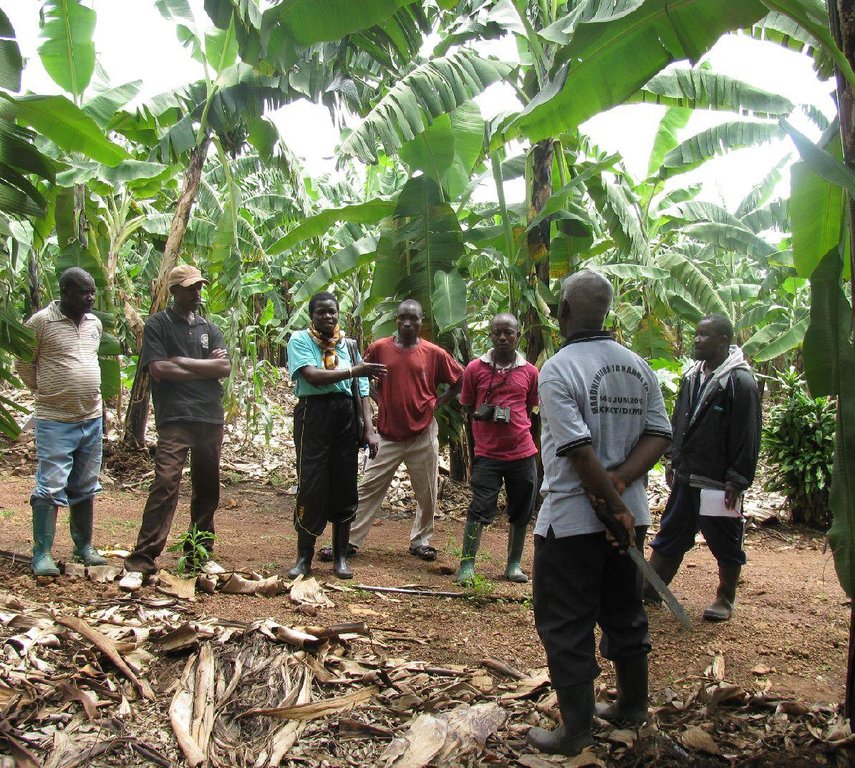Integrated farm knowledge adoption [Tanzania, United Republic of]
- Creation:
- Update:
- Compiler: Jasson Rwazo
- Editor: –
- Reviewer: Fabian Ottiger
Tweyambe
approaches_2677 - Tanzania, United Republic of
View sections
Expand all Collapse all1. General information
1.2 Contact details of resource persons and institutions involved in the assessment and documentation of the Approach
1.3 Conditions regarding the use of data documented through WOCAT
When were the data compiled (in the field)?
11/07/2012
The compiler and key resource person(s) accept the conditions regarding the use of data documented through WOCAT:
Ja
1.4 Reference(s) to Questionnaire(s) on SLM Technologies

Improved Kibanja cropping system [Tanzania, United Republic of]
This is a traditional banana and coffee complex cropping system interplanted with annual crops, trees,shrubs, vegetables and other diverse plants of social economic importance.
- Compiler: Jasson Rwazo
2. Description of the SLM Approach
2.1 Short description of the Approach
The way and means through which a performing farmers adopt and use a combination of indigenous and scientific to maximaze production.
2.2 Detailed description of the Approach
Detailed description of the Approach:
Aims / objectives: To adopt and combine indigenous (traditional) and Scientific knowledge in Kibanja system to improve farm productivity through soil and water use efficiency.
Methods: Continuous adoption of indigenous knowledge through story telling and experience
Adoption of technical knowledge extension officers, knowledgeable farmers, projects and research agencies
Implementing the adopted knowledge to the farm
Stages of implementation: Area identification
Area planned phased and rehabilitation and mitigation
Continuous monitoring and supervision to prevent degradation
Introduce small and large stock for manure production
Role of stakeholders: Land user: Promote and use the technology
Community:Maine implementor of the technology,Source of labour
Extension and research:Provision of technical advise
Financial institution for financial capital support
Clan/Family: Family labour
Other important information: Though land ownership is through customary law, but approach is used by both gender, all family members benefit equally from the use of the approach.
Application of this approach needs integrative and proper conceptual understanding of both indigenous and
2.3 Photos of the Approach
2.5 Country/ region/ locations where the Approach has been applied
Country:
Tanzania, United Republic of
Region/ State/ Province:
Kagera
Further specification of location:
Missenyi
2.7 Type of Approach
- Integrated knowledge adoption(traditional,innovative,project)
2.8 Main aims/ objectives of the Approach
The Approach focused mainly on SLM with other activities (Improvement of house hold food security and income)
To improve agricultural production and productivity
Sustainable utilization of land and water
To minimize loss during adverse condition (drought/Wind)
To improve house hold food security,income and livelihood
The SLM Approach addressed the following problems: Low agricultural production
Inadequate complementary use of indigenous and technical knowledge
Poor livelihood and income
2.9 Conditions enabling or hindering implementation of the Technology/ Technologies applied under the Approach
availability/ access to financial resources and services
- hindering
Inadequate financial capital
Treatment through the SLM Approach: Phase/Stepwise rehabilitation and expansion
Introducing saving and credit scheme through village bank
knowledge about SLM, access to technical support
- hindering
Lack of proper integration of indigenous scientific knowledge
Treatment through the SLM Approach: Research
workload, availability of manpower
- hindering
Lab our intensive
Treatment through the SLM Approach: To modernize the technology to allow mechanisation
3. Participation and roles of stakeholders involved
3.1 Stakeholders involved in the Approach and their roles
- local land users/ local communities
Land user and casual labour
Approach requires capita
- researchers
Research institute
If several stakeholders were involved, indicate lead agency:
Elders developed the approach through trial and error
3.2 Involvement of local land users/ local communities in the different phases of the Approach
| Involvement of local land users/ local communities | Specify who was involved and describe activities | |
|---|---|---|
| initiation/ motivation | self-mobilization | Land user and his family |
| planning | self-mobilization | Land user and his family |
| implementation | self-mobilization | Land user and his family |
| monitoring/ evaluation | self-mobilization | Land user and his family |
| Research | self-mobilization | Land user and his family |
3.4 Decision-making on the selection of SLM Technology/ Technologies
Specify who decided on the selection of the Technology/ Technologies to be implemented:
- land users alone (self-initiative)
Explain:
The land user through his own initiative basing on experience and interaction with other land user and experts decide on the proper technology to use
Decisions on the method of implementing the SLM Technology were made by by land users* alone (self-initiative / bottom-up). The land user through his own initiative basing on experience and interaction with other land user and experts decide on the proper technology to implementation of the technology
5. Financing and external material support
5.1 Annual budget for the SLM component of the Approach
If precise annual budget is not known, indicate range:
- 2,000-10,000
Comments (e.g. main sources of funding/ major donors):
Approach costs were met by the following donors: local community / land user(s) (Land user on his own): 100.0%
6. Impact analysis and concluding statements
6.1 Impacts of the Approach
Did the Approach help land users to implement and maintain SLM Technologies?
- No
- Yes, little
- Yes, moderately
- Yes, greatly
Increase of the size of banana bunch, control of erosion and soil nutrient loss
Did the Approach empower socially and economically disadvantaged groups?
- No
- Yes, little
- Yes, moderately
- Yes, greatly
Did other land users / projects adopt the Approach?
- No
- Yes, little
- Yes, moderately
- Yes, greatly
Did the Approach lead to improved livelihoods / human well-being?
- No
- Yes, little
- Yes, moderately
- Yes, greatly
Did the Approach help to alleviate poverty?
- No
- Yes, little
- Yes, moderately
- Yes, greatly
7. References and links
7.1 Methods/ sources of information
- field visits, field surveys
- interviews with land users
Links and modules
Expand all Collapse allLinks

Improved Kibanja cropping system [Tanzania, United Republic of]
This is a traditional banana and coffee complex cropping system interplanted with annual crops, trees,shrubs, vegetables and other diverse plants of social economic importance.
- Compiler: Jasson Rwazo
Modules
No modules




